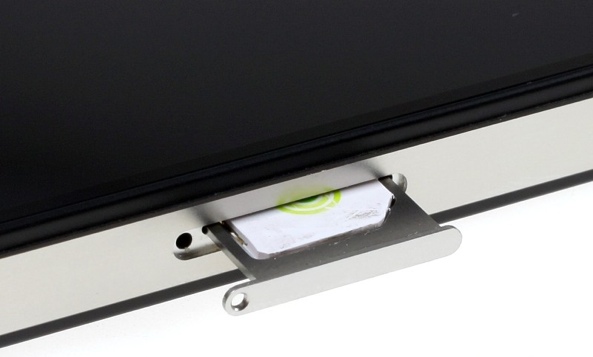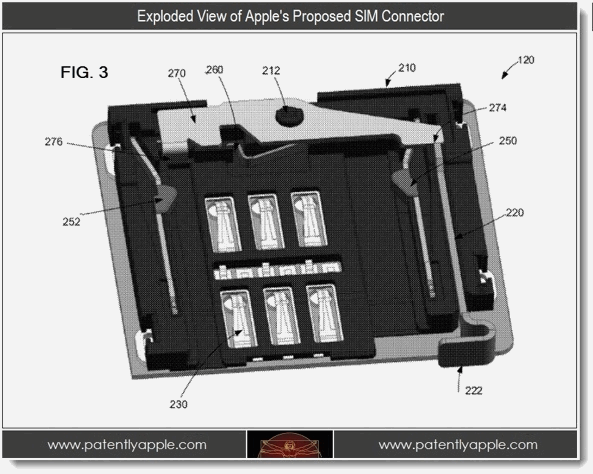As Apple fights rivals Nokia, Motorola and Research In Motion for the upcoming Nano SIM card standard, a new patent filing indicates the company is thinking beyond smartphones. The iPhone maker already holds an important Nano SIM patent and now we’ve learned they’re researching a universal SIM card connector solution.
Yes, it would require a “drawer” and devices would need to be engineered with this in mind, but the benefits offset engineering hassles. Apple’s SIM card connector solution could let you transfer a SIM card from one device to another. Plus, it is reliable and resistant to damage by an improper insertion of a SIM card.
It even works with Integrated Circuit Card found in credit cards, broadening potential uses to e-commerce applications. And if this patent filing is an indication, Apple’s universal SIM connector could be coming to a MacBook Pro, iPhone, iPad, iPod touch and Apple television near you…
Patently Apple observes:
The ability to transfer a SIM from one device to another is perhaps one of the advantages to Apple’s design and why the ETSI is strongly considering it as a standard. In the era of mobility and device interconnectivity, Apple’s solution may be the winner.
The benefits of Apple’s solution include easy removal of a SIM card, resistance to damage by an improper insertion of a SIM card and reliable mechanical performance.
A patent application filed with the United States Patents & Trademark Office (USPTO) describes a “plunger system” where a user can push a plunger rod and eject a SIM card. Reinserting the card is a simple matter of pushing the card into the connector.
Resistance to damage could be achieved with internal contacts arranged in such a way that they have a low profile, which would protect the contacts from damage due to an improper insertion of a SIM card.
Apple’s filing envisions uses of the SIM connector beyond smartphones. The document mentions tablet computers, laptops, media players and even displays (think iTV) as benefiting from this invention.
The most interesting aspect is the SIM card itself.
According to Apple, the SIM connector could work with Micro SIM as well as Mini SIM, provided the latter is inserted in a mini SIM card tray. More importantly, the SIM connector would work with the upcoming Nano SIM and even Integrated Circuit Card (ICC) used, for example, in Visa credit cards.
The publication explains:
Apple’s mystery inclusion of “other type of card” in this application could be demystified by their latest granted patent which discusses the use of an Integrated Circuit Card (ICC) in connection with a SIM Tray. An ICC is what is used in Visa credit cards, for example. This translates to ICC’s being integrated into an iPhone or other mobile device via a mini-tray system for the purposes of ecommerce. This was covered in our report titled “Apple Wins Patent Relating to Nano SIM and iWallet Chip.” This is a huge advantage in Apple’s SIM strategy and one that could be helpful to the entire industry. This is likely why Apple’s SIM card standard is being considered by the ETSI.
Summing up, no wonder Apple crossed swords with Nokia over the Nano SIM standard. Obviously, there’s more to the Apple-backed Nano SIM variant than meets the eye.
The European Telecommunications Standards Institute will vote on Nano SIM in about 30 days.
Apple on its part promised to offer own Nano SIM solution to industry players on a royalty-free basis. The opposing camp did not make such a commitment.
It is now becoming obvious why exactly RIM has resorted to name calling and why Nokia is threatening not to license essential SIM-related patents should Apple prevail.
See, there’s nothing stopping Nokia from extracting license fees from competitors in case their Nano SIM proposal wins. Yes, it all comes down to patents and money – at least for Nokia, RIM and Motorola.
Not bad for a tiny SIM card.
I’d love to hear your thoughts on Apple’s SIM connector patent down in the comments.


